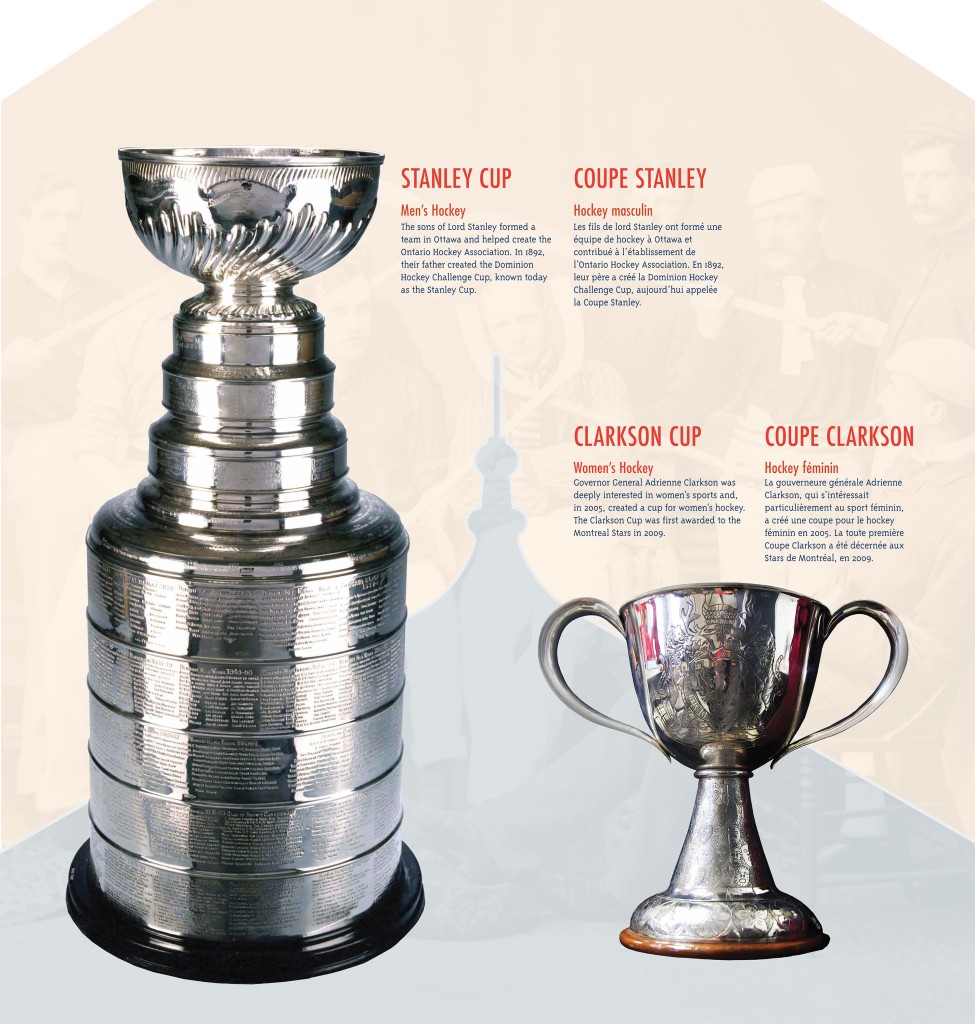The history of ice hockey has deep roots in the national capital region, dating back to the 1800’s. This bike tour visits a few sites around town that commemorate the development of this popular winter sport.
We begin at the north-west corner of Gladstone and Bay. Here you will find a polished black stone pedestal commemorating the location of Dey’s Skating Rink , built in 1896 and considered to be the first Canadian hockey arena. It was twice destroyed: once in 1902 by a terrible windstorm, and then by fire in 1920. Here in 1903 the Ottawa Hockey Club defeated the Montreal Victoria’s to bring Ottawa it’s first Stanley Cup championship.


The story of the Stanley Cup is expanded upon at our second stop on the tour. Head north along the Bay Street bike path, then right along Sparks Street which has no motorised vehicular traffic.
At the eastern end of Sparks Street you will find an installation titled Lord Stanley’s Gift, the focal point of which is a huge abstraction of the silver punch bowl donated by Canada’s 6th Governor General, Lord Stanley, who had written, ‘ I have for some time been thinking that it would be a good thing if there were a challenge cup which should be held from year to year by the champion hockey team in the Dominion‘. This award was first presented in 1893 to to the Montreal Amateur Athletic Association.

The tall columnar base of the modern Stanley Cup is not included on this display. this base, consisting of stacked silver bands with inscribed names of winning team players, was not part of the original cup donated by Lord Stanley. The bands also get replaced with more recent winning team players names.
Our third stop on the tour is in Gatineau on the corner of Jacques Cartier park across the street from the Canadian Museum of History. Here you will find a HUGE bronze sculpture titled ‘Never Give Up’ of Maurice Richard, legendary player of the Montreal Canadiens from 1942 – 1960.
Getting there from Sparks Street is a little tricky by bike. I suggest walking your bike along the sidewalk the few hundred yards to the bi-directional bike path along Mackenzie Avenue that only starts heading north at the corner of Mackenzie and Wellington (see red line on map) as there is no safe bike infrastructure between these two points. Once on the bike path head north along Mackenzie and then turn left onto the bike path along Murray street that transitions to the bike path over the Alexandra Bridge. Once on the other side, turn right across at the lights where you will find the sculpture of Maurice Richard on the opposite side.
Richard took on a strong symbolic role throughout Quebec in the period leading up to the Quiet Revolution. The Richard Riot broke out in Montreal when he was suspended for the remainder of the 1954-55 season by commisioner Clarence Campbell after a violent on ice confrontation. He was further popularised in Roch Carrier’s book The Hockey Sweater and was the first Quebec non-politician to be given a state funeral.

Our final destination on the tour is on the grounds of Rideau Hall at the Governor General’s skating rink, however this destination will have to wait until the threat of Covid is in the past. I have indicated this route with a purple line on the map and will elaborate on it once the rink is again open to the public. Once it is here you will find a great exhibit (designed by Carla Ayukawa of Evolution Design) on the roles various Governor Generals have played in promoting winter sports. Particular to hockey, there is information on the rink itself, the Stanley Cup, as well as the Clarkson Cup, donated by Governor General Adrienne Clarkson, first awarded to the Canadian national women’s hockey team in 2006.




Et voila!

